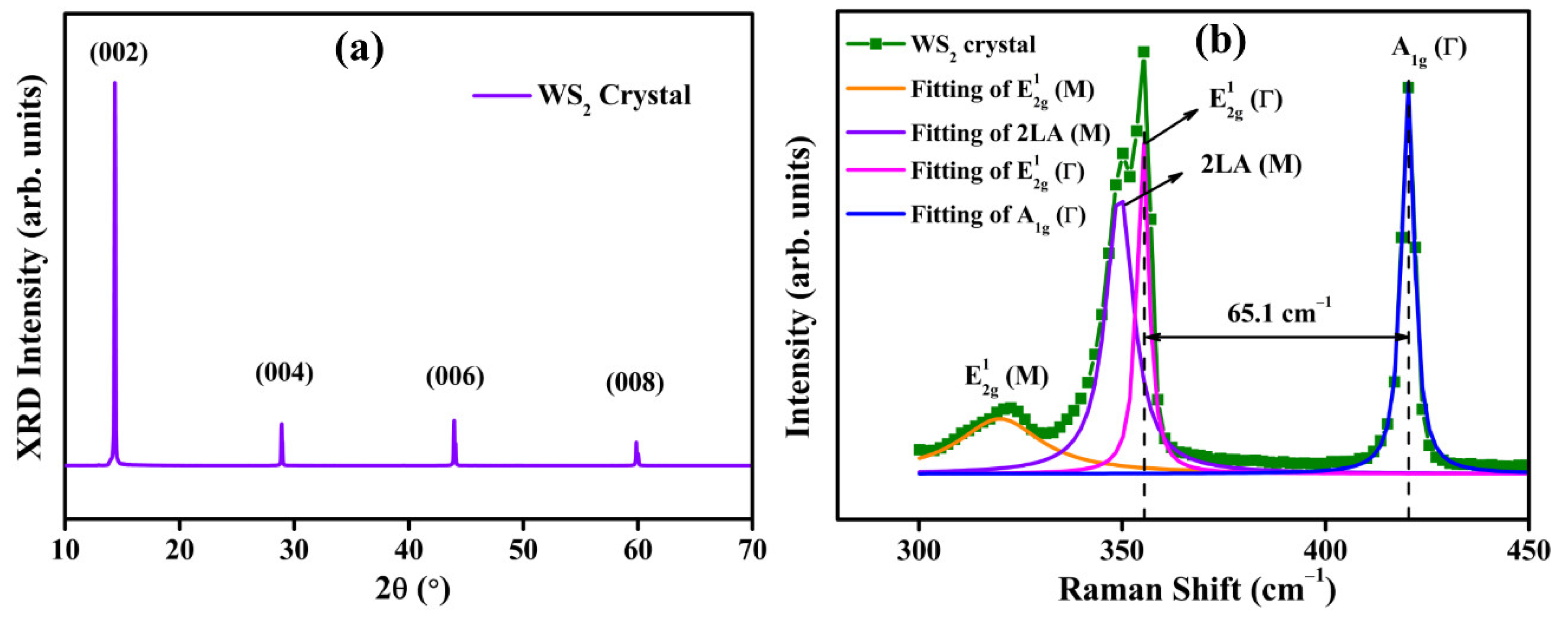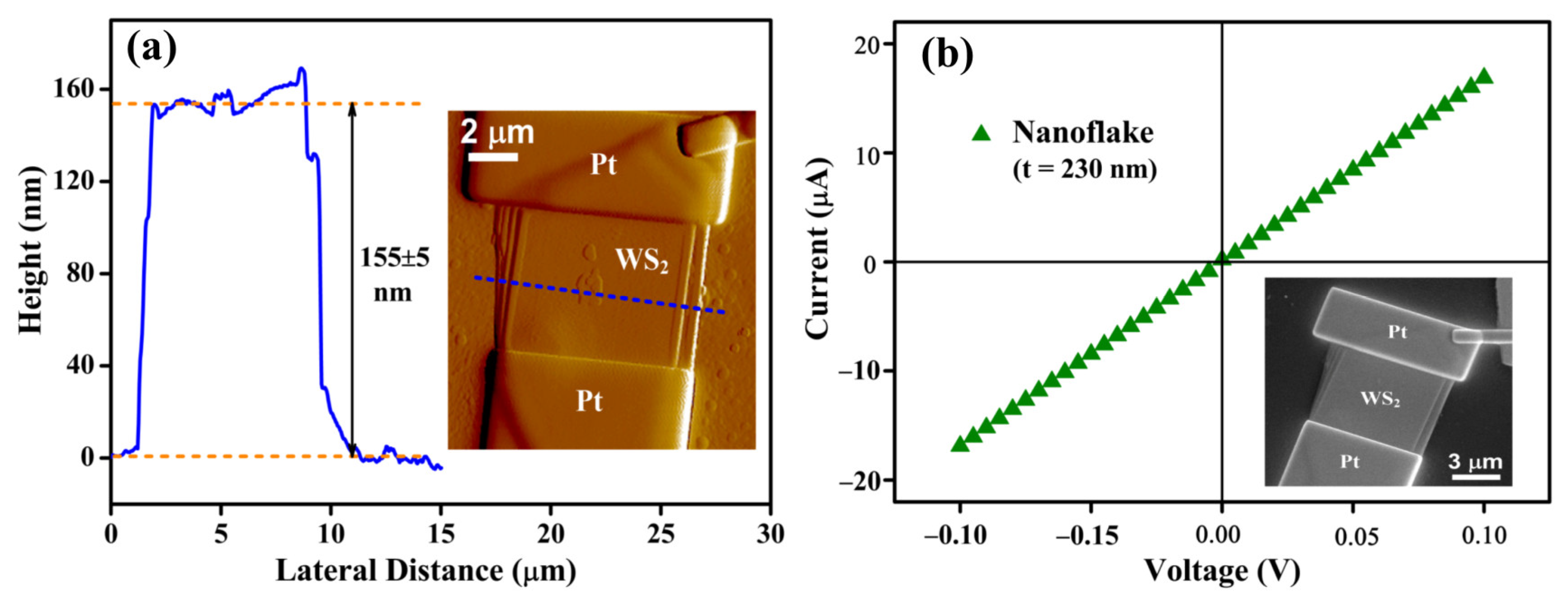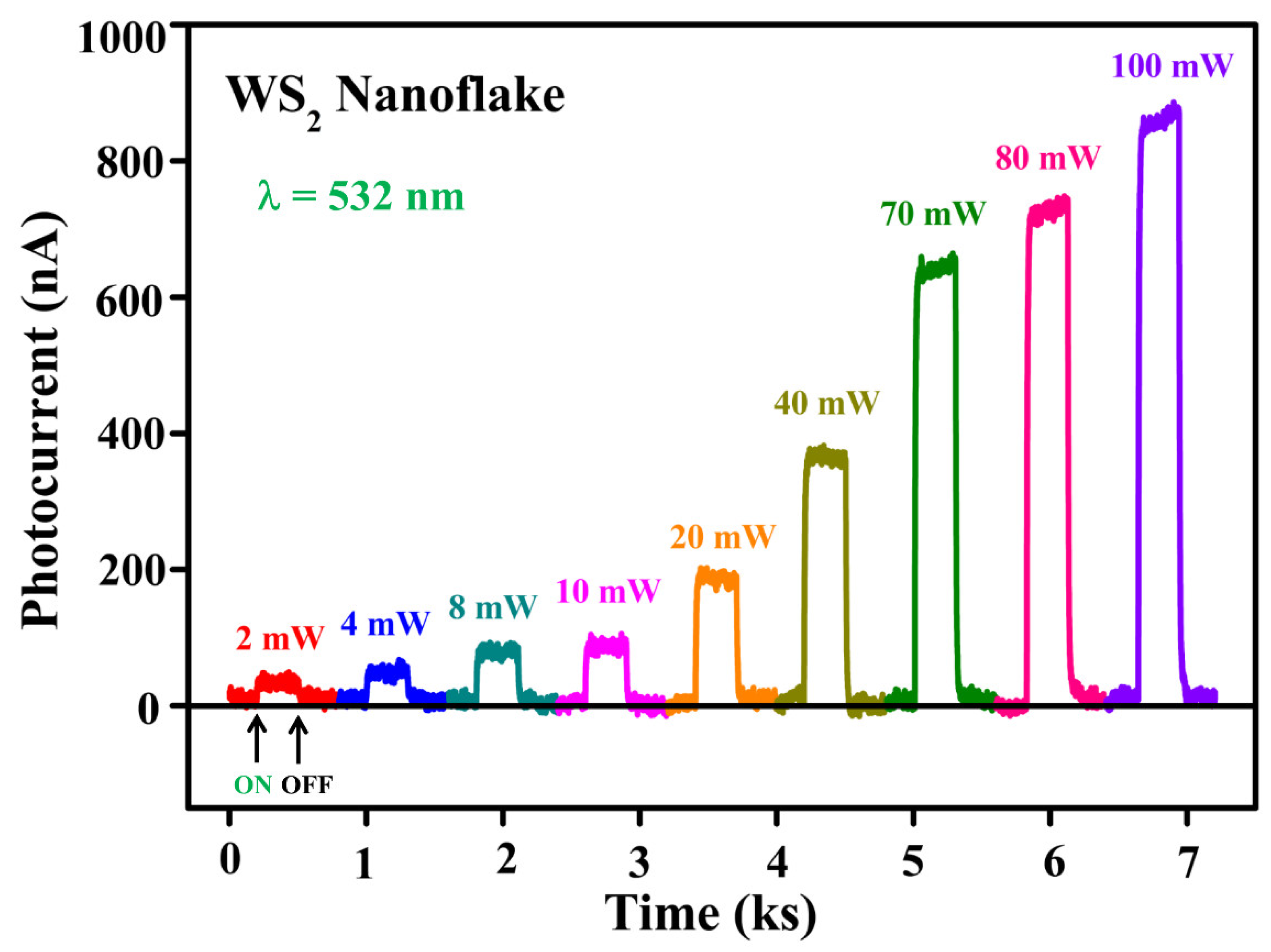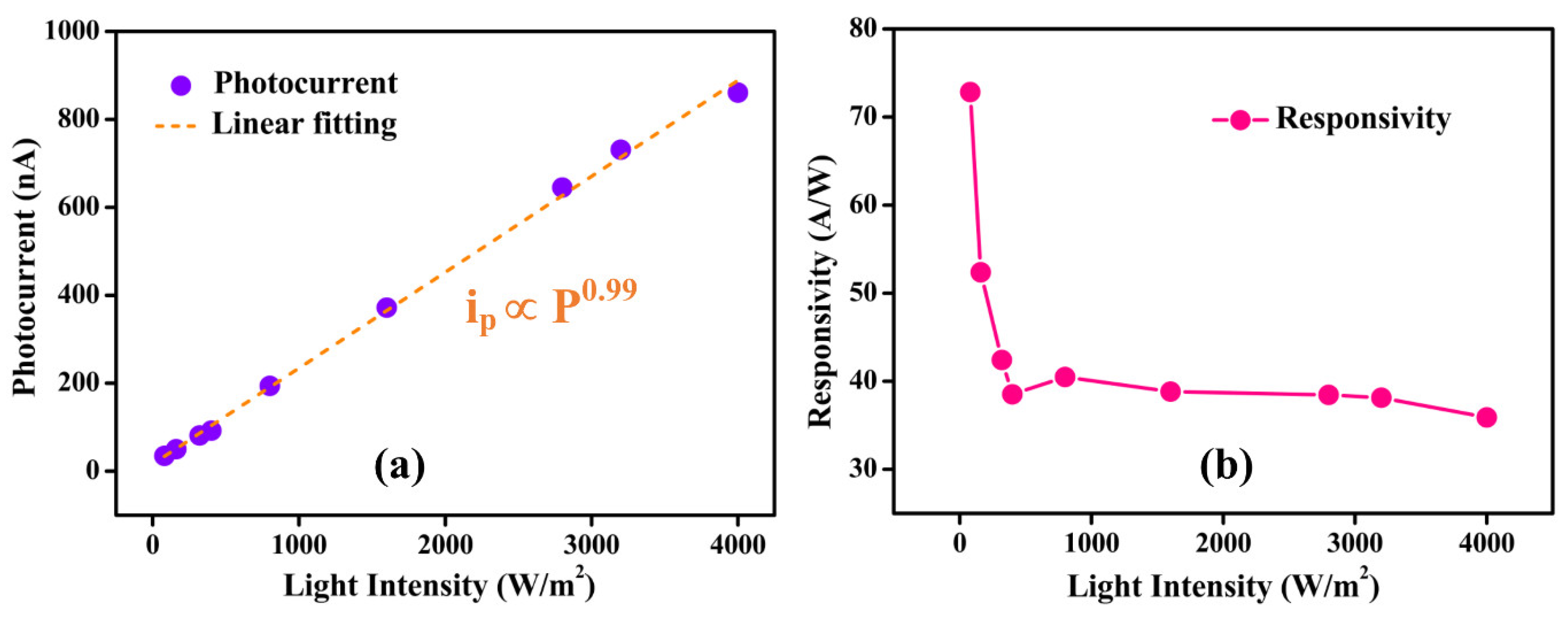Photoconduction Properties in Tungsten Disulfide Nanostructures
Abstract
:1. Introduction
2. Materials and Methods
2.1. WS2 Crystal Growth
2.2. Fabrication of WS2 Photodetector
2.3. Measurements and Characterization
3. Results and Discussion
3.1. WS2 Crystal Characterization
3.2. WS2 Nanoflake Device Characterization
3.3. Photoconduction Properties of WS2 Nanoflake
4. Conclusions
Author Contributions
Funding
Data Availability Statement
Acknowledgments
Conflicts of Interest
References
- Yang, W.; Hu, K.; Teng, F.; Weng, J.; Zhang, Y.; Fang, X. High-Performance Silicon-Compatible Large-Area UV-to-Visible Broadband Photodetector Based on Integrated Lattice-Matched Type II Se/n-Si Heterojunctions. Nano Lett. 2018, 18, 4697–4703. [Google Scholar] [CrossRef] [PubMed]
- Basyooni, M.A.; Zaki, S.E.; Alfryyan, N.; Tihtih, M.; Eker, Y.R.; Attia, G.F.; Yılmaz, M.; Ateş, Ş.; Shaban, M. Nanostructured MoS2 and WS2 Photoresponses under Gas Stimuli. Nanomaterials 2022, 12, 3585. [Google Scholar] [CrossRef] [PubMed]
- Dam, S.; Saha, A.; Hussain, S. Photoresponse Properties of Thin Films of Vertically Grown WS2 Nanoflakes. Mater. Sci. Eng. B Solid-State Mater. Adv. Technol. 2022, 277, 115587. [Google Scholar] [CrossRef]
- Fang, H.; Hu, W. Photogating in Low Dimensional Photodetectors. Adv. Sci. 2017, 4, 1700323. [Google Scholar] [CrossRef] [PubMed]
- Xie, C.; Mak, C.; Tao, X.; Yan, F. Photodetectors Based on Two-Dimensional Layered Materials Beyond Graphene. Adv. Funct. Mater. 2017, 27, 1603886. [Google Scholar] [CrossRef]
- Ghanghass, A.; Sameera, I.; Bhatia, R. Multi-Layer Growth of Tungsten Disulphide Using Thermal Chemical Vapour Deposition. Mater. Today Proc. 2023, 74, 197–201. [Google Scholar] [CrossRef]
- Tan, H.; Fan, Y.; Zhou, Y.; Chen, Q.; Xu, W.; Warner, J.H. Ultrathin 2D Photodetectors Utilizing Chemical Vapor Deposition Grown WS2 with Graphene Electrodes. ACS Nano 2016, 10, 7866–7873. [Google Scholar] [CrossRef]
- Choi, W.; Choudhary, N.; Han, G.H.; Park, J.; Akinwande, D.; Lee, Y.H. Recent Development of Two-Dimensional Transition Metal Dichalcogenides and Their Applications. Mater. Today 2017, 20, 116–130. [Google Scholar] [CrossRef]
- Wang, H.; Yu, L.; Lee, Y.H.; Shi, Y.; Hsu, A.; Chin, M.L.; Li, L.J.; Dubey, M.; Kong, J.; Palacios, T. Integrated Circuits Based on Bilayer MoS2 Transistors. Nano Lett. 2012, 12, 4674–4680. [Google Scholar] [CrossRef] [Green Version]
- Jariwala, D.; Sangwan, V.K.; Lauhon, L.J.; Marks, T.J.; Hersam, M.C. Emerging Device Applications for Semiconducting Two-Dimensional Transition Metal Dichalcogenides. ACS Nano 2014, 8, 1102–1120. [Google Scholar] [CrossRef] [Green Version]
- Zhu, W.; Low, T.; Wang, H.; Ye, P.; Duan, X. Nanoscale Electronic Devices Based on Transition Metal Dichalcogenides. 2D Mater. 2019, 6, 032004. [Google Scholar] [CrossRef]
- Yin, Z.; Li, H.; Li, H.; Jiang, L.; Shi, Y.; Sun, Y.; Lu, G.; Zhang, Q.; Chen, X.; Zhang, H. Single-Layer MoS2 Phototransistors. ACS Nano 2012, 6, 74–80. [Google Scholar] [CrossRef] [PubMed] [Green Version]
- Choi, W.; Cho, M.Y.; Konar, A.; Lee, J.H.; Cha, G.B.; Hong, S.C.; Kim, S.; Kim, J.; Jena, D.; Joo, J.; et al. High-Detectivity Multilayer MoS2 Phototransistors with Spectral Response from Ultraviolet to Infrared. Adv. Mater. 2012, 24, 5832–5836. [Google Scholar] [CrossRef] [PubMed]
- Tsai, D.S.; Liu, K.K.; Lien, D.H.; Tsai, M.L.; Kang, C.F.; Lin, C.A.; Li, L.J.; He, J.H. Few-Layer MoS2 with High Broadband Photogain and Fast Optical Switching for Use in Harsh Environments. ACS Nano 2013, 7, 3905–3911. [Google Scholar] [CrossRef]
- Aji, A.S.; Solís-Fernández, P.; Ji, H.G.; Fukuda, K.; Ago, H. High Mobility WS2 Transistors Realized by Multilayer Graphene Electrodes and Application to High Responsivity Flexible Photodetectors. Adv. Funct. Mater. 2017, 27, 1703448. [Google Scholar] [CrossRef]
- Lan, C.; Li, C.; Yin, Y.; Liu, Y. Large-Area Synthesis of Monolayer WS2 and Its Ambient-Sensitive Photo-Detecting Performance. Nanoscale 2015, 7, 5974–5980. [Google Scholar] [CrossRef] [PubMed]
- Li, H.J.W.; Huang, K.; Zhang, Y. Enhanced Photoresponsivity of the GOQDs Decorated WS2 Photodetector. Mater. Res. Express 2019, 6, 045902. [Google Scholar] [CrossRef]
- Pawbake, A.S.; Waykar, R.G.; Late, D.J.; Jadkar, S.R. Highly Transparent Wafer-Scale Synthesis of Crystalline WS2 Nanoparticle Thin Film for Photodetector and Humidity-Sensing Applications. ACS Appl. Mater. Interfaces 2016, 8, 3359–3365. [Google Scholar] [CrossRef] [PubMed]
- Li, J.; Han, J.; Li, H.; Fan, X.; Huang, K. Large-Area, Flexible Broadband Photodetector Based on WS2 Nanosheets Films. Mater. Sci. Semicond. Process. 2020, 107, 104804. [Google Scholar] [CrossRef]
- Yang, Y.; Liu, G.; Li, P.; Zhang, M.; Wang, J.; Hu, W.; Xue, Z.; Di, Z. High-Performance Broadband Tungsten Disulfide Photodetector Decorated with Indium Arsenide Nanoislands. Phys. Status Solidi Appl. Mater. Sci. 2020, 217, 2000297. [Google Scholar] [CrossRef]
- Ahmad, H.; Thandavan, T.M.K. Ultraviolet Photoconduction in Tungsten Disulphide Based Schottky Heterostructure Photodetector. Opt. Mater. 2019, 92, 255–261. [Google Scholar] [CrossRef]
- Yadav, P.V.K.; Ashok Kumar Reddy, Y. Controlled Two-Step Synthesis of Nanostructured WS2 Thin Films for Enhanced UV–Visible Photodetector Applications. Sens. Actuators A Phys. 2022, 345, 113780. [Google Scholar] [CrossRef]
- Rivera, A.M.; Gaur, A.P.S.; Sahoo, S.; Katiyar, R.S. Studies on Chemical Charge Doping Related Optical Properties in Monolayer WS2. J. Appl. Phys. 2016, 120, 105102. [Google Scholar] [CrossRef]
- Perrozzi, F.; Emamjomeh, S.M.; Paolucci, V.; Taglieri, G.; Ottaviano, L.; Cantalini, C. Thermal Stability of WS2 Flakes and Gas Sensing Properties of WS2/WO3 Composite to H2, NH3 and NO2. Sens. Actuators B Chem. 2017, 243, 812–822. [Google Scholar] [CrossRef]
- Liu, L.; Kumar, S.B.; Ouyang, Y.; Guo, J. Performance Limits of Monolayer Transition Metal Dichalcogenide Transistors. IEEE Trans. Electron. Devices 2011, 58, 3042–3047. [Google Scholar] [CrossRef] [Green Version]
- Yao, J.D.; Zheng, Z.Q.; Shao, J.M.; Yang, G.W. Stable, Highly-Responsive and Broadband Photodetection Based on Large-Area Multilayered WS2 Films Grown by Pulsed-Laser Deposition. Nanoscale 2015, 7, 14974–14981. [Google Scholar] [CrossRef] [PubMed]
- Esfandiari, M.; Mohajerzadeh, S. Formation of Large Area WS2 Nanosheets Using an Oxygen-Plasma Assisted Exfoliation Suitable for Optical Devices. Nanotechnology 2019, 30, 204. [Google Scholar] [CrossRef] [PubMed]
- Park, J.; Lee, W.; Choi, T.; Hwang, S.H.; Myoung, J.M.; Jung, J.H.; Kim, S.H.; Kim, H. Layer-Modulated Synthesis of Uniform Tungsten Disulfide Nanosheet Using Gas-Phase Precursors. Nanoscale 2015, 7, 1308–1313. [Google Scholar] [CrossRef]
- Georgiou, T.; Jalil, R.; Belle, B.D.; Britnell, L.; Gorbachev, R.V.; Morozov, S.V.; Kim, Y.J.; Gholinia, A.; Haigh, S.J.; Makarovsky, O.; et al. Vertical Field-Effect Transistor Based on Graphene-WS2 Heterostructures for Flexible and Transparent Electronics. Nat. Nanotechnol. 2013, 8, 100–103. [Google Scholar] [CrossRef]
- Huo, N.; Yang, S.; Wei, Z.; Li, S.S.; Xia, J.B.; Li, J. Photoresponsive and Gas Sensing Field-Effect Transistors Based on Multilayer WS2 Nanoflakes. Sci. Rep. 2014, 4, 5209. [Google Scholar] [CrossRef] [Green Version]
- Mohan, V.V.; Manuraj, M.; Anjana, P.M.; Rakhi, R.B. WS2 Nanoflowers as Efficient Electrode Materials for Supercapacitors. Energy Technol. 2022, 10, 2100976. [Google Scholar] [CrossRef]
- Sheng, Y.; Chen, T.; Lu, Y.; Chang, R.J.; Sinha, S.; Warner, J.H. High-Performance WS2 Monolayer Light-Emitting Tunneling Devices Using 2D Materials Grown by Chemical Vapor Deposition. ACS Nano 2019, 13, 4530–4537. [Google Scholar] [CrossRef] [PubMed]
- Hasani, A.; Nguyen, T.P.; Tekalgne, M.; VanLe, Q.; Choi, K.S.; Lee, T.H.; Jung Park, T.; Jang, H.W.; Kim, S.Y. The Role of Metal Dopants in WS2 Nanoflowers in Enhancing the Hydrogen Evolution Reaction. Appl. Catal. A Gen. 2018, 567, 73–79. [Google Scholar] [CrossRef]
- Li, Y.; Chernikov, A.; Zhang, X.; Rigosi, A.; Hill, H.M.; Van DerZande, A.M.; Chenet, D.A.; Shih, E.M.; Hone, J.; Heinz, T.F. Measurement of the Optical Dielectric Function of Monolayer Transition-Metal Dichalcogenides: MoS2, MoSe2, WS2, and WSe2. Phys. Rev. B—Condens. Matter Mater. Phys. 2014, 90, 205422. [Google Scholar] [CrossRef] [Green Version]
- Palik, E.D. Handbook of Optical Constants of Solids III; Academic Press: San Diego, CA, USA, 1998. [Google Scholar]
- Yang, R.; Feng, S.; Xiang, J.; Jia, Z.; Mu, C.; Wen, F.; Liu, Z. Ultrahigh-Gain and Fast Photodetectors Built on Atomically Thin Bilayer Tungsten Disulfide Grown by Chemical Vapor Deposition. ACS Appl. Mater. Interfaces 2017, 9, 42001–42010. [Google Scholar] [CrossRef] [PubMed]
- Kim, H.C.; Kim, H.; Lee, J.U.; Lee, H.B.; Choi, D.H.; Lee, J.H.; Lee, W.H.; Jhang, S.H.; Park, B.H.; Cheong, H.; et al. Engineering Optical and Electronic Properties of WS2 by Varying the Number of Layers. ACS Nano 2015, 9, 6854–6860. [Google Scholar] [CrossRef]
- Zhao, W.; Ghorannevis, Z.; Chu, L.; Toh, M.; Kloc, C.; Tan, P.-H.; Eda, G. Evolution of Electronic Structure in Atomically Thin Sheets of WS2 and WSe2. ACS Nano 2013, 7, 791–797. [Google Scholar] [CrossRef] [Green Version]
- Roy, A.; Kalita, P.; Mondal, B. Structural, Spectroscopic and Electrical Properties of Liquid Phase Exfoliated Few Layered Two-Dimensional Tungsten Disulfide (WS2) Using Anionic Surfactant. J. Mater. Sci. Mater. Electron. 2023, 34, 224. [Google Scholar] [CrossRef]
- Hwan Lee, S.; Lee, D.; Sik Hwang, W.; Hwang, E.; Jena, D.; Jong Yoo, W. High-Performance Photocurrent Generation from Two-Dimensional WS2 Field-Effect Transistors. Appl. Phys. Lett. 2014, 104, 193113. [Google Scholar] [CrossRef] [Green Version]
- Huo, N.; Kang, J.; Wei, Z.; Li, S.S.; Li, J.; Wei, S.H. Novel and Enhanced Optoelectronic Performances of Multilayer MoS2-WS2 Heterostructure Transistors. Adv. Funct. Mater. 2014, 24, 7025–7031. [Google Scholar] [CrossRef]
- Habib, M.; Khalil, A.; Muhammad, Z.; Khan, R.; Wang, C.; Rehman, Z.u.; Masood, H.T.; Xu, W.; Liu, H.; Gan, W.; et al. WX2 (X=S, Se) Single Crystals: A Highly Stable Material for Supercapacitor Applications. Electrochim. Acta 2017, 258, 71–79. [Google Scholar] [CrossRef]
- Lin, D.Y.; Shih, Y.T.; Lin, P.C.; Tseng, B.C.; Hwang, S.B.; Kao, M.C. Photoelectric Properties of Pristine and Niobium-Doped Tungsten Disulfide Layered Crystals. Opt. Mater. 2023, 135, 113310. [Google Scholar] [CrossRef]
- Lan, C.; Li, C.; Ho, J.C.; Liu, Y. 2D WS2: From Vapor Phase Synthesis to Device Applications. Adv. Electron. Mater. 2021, 7, 2000688. [Google Scholar] [CrossRef]
- Zobeiri, H.; Xu, S.; Yue, Y.; Zhang, Q.; Xie, Y.; Wang, X. Effect of Temperature on Raman Intensity of nm-thick WS2: Combined Effects of Resonance Raman, Optical Properties, and Interface Optical Interference. Nanoscale 2020, 12, 6064–6078. [Google Scholar] [CrossRef]
- Berkdemir, A.; Gutiérrez, H.R.; Botello-Méndez, A.R.; Perea-López, N.; Elías, A.L.; Chia, C.I.; Wang, B.; Crespi, V.H.; López-Urías, F.; Charlier, J.C.; et al. Identification of Individual and Few Layers of WS2 Using Raman Spectroscopy. Sci. Rep. 2013, 3, 1755. [Google Scholar] [CrossRef] [Green Version]
- Sourisseau, C.; Cruege, F.; Fouassier, M.; Alba, M. Second-Order Raman Effects, Inelastic Neutron Scattering and Lattice Dynamics in 2H-WS2. Chem. Phys. 1991, 150, 281–293. [Google Scholar] [CrossRef]
- Zeng, H.; Liu, G.B.; Dai, J.; Yan, Y.; Zhu, B.; He, R.; Xie, L.; Xu, S.; Chen, X.; Yao, W.; et al. Optical Signature of Symmetry Variations and Spin-Valley Coupling in Atomically Thin Tungsten Dichalcogenides. Sci. Rep. 2013, 3, 2–6. [Google Scholar] [CrossRef] [Green Version]
- Mitioglu, A.A.; Plochocka, P.; Deligeorgis, G.; Anghel, S.; Kulyuk, L.; Maude, D.K. Second-Order Resonant Raman Scattering in Single-Layer Tungsten Disulfide WS2. Phys. Rev. B—Condens. Matter Mater. Phys. 2014, 89, 245442. [Google Scholar] [CrossRef] [Green Version]
- Huang, Y.H.; Chen, R.S.; Zhang, J.R.; Huang, Y.S. Electronic Transport in NbSe2 Two-Dimensional Nanostructures: Semiconducting Characteristics and Photoconductivity. Nanoscale 2015, 7, 18964–18970. [Google Scholar] [CrossRef]
- Bangolla, H.K.; Siao, M.D.; Huang, Y.H.; Chen, R.S.; Žukauskaitė, A.; Palisaitis, J.; Persson, P.O.Å.; Hultman, L.; Birch, J.; Hsiao, C.L. Composition-Dependent Photoconductivities in Indium Aluminium Nitride Nanorods Grown by Magnetron Sputter Epitaxy. Nanoscale Adv. 2022, 4, 4886–4894. [Google Scholar] [CrossRef]
- Zeng, L.; Tao, L.; Tang, C.; Zhou, B.; Long, H.; Chai, Y.; Lau, S.P.; Tsang, Y.H. High-Responsivity UV-Vis Photodetector Based on Transferable WS2 Film Deposited by Magnetron Sputtering. Sci. Rep. 2016, 6, 20343. [Google Scholar] [CrossRef] [Green Version]
- Kind, H.; Yan, H.; Messer, B.; Law, M.; Yang, P. Nanowire Ultraviolet Photodetectors and Optical Switches. Adv. Mater. 2002, 14, 158–160. [Google Scholar] [CrossRef]
- Hafeez, M.; Gan, L.; Li, H.; Ma, Y.; Zhai, T. Large-Area Bilayer ReS2 Film/Multilayer ReS2 Flakes Synthesized by Chemical Vapor Deposition for High Performance Photodetectors. Adv. Funct. Mater. 2016, 26, 4551–4560. [Google Scholar] [CrossRef]
- Yang, H.W.; Hsieh, H.F.; Chen, R.S.; Ho, C.H.; Lee, K.Y.; Chao, L.C. Ultraefficient Ultraviolet and Visible Light Sensing and Ohmic Contacts in High-Mobility InSe Nanoflake Photodetectors Fabricated by the Focused Ion Beam Technique. ACS Appl. Mater. Interfaces 2018, 10, 5740–5749. [Google Scholar] [CrossRef]
- Lan, C.; Zhou, Z.; Zhou, Z.; Li, C.; Shu, L.; Shen, L.; Li, D.; Dong, R.; Yip, S.P.; Ho, J.C. Wafer-Scale Synthesis of Monolayer WS2 for High-Performance Flexible Photodetectors by Enhanced Chemical Vapor Deposition. Nano Res. 2018, 11, 3371–3384. [Google Scholar] [CrossRef]
- Zhuo, R.; Zuo, S.; Quan, W.; Yan, D.; Geng, B.; Wang, J.; Men, X. Large-Size and High Performance Visible-Light Photodetectors Based on Two-Dimensional Hybrid Materials SnS/RGO. RSC Adv. 2018, 8, 761–766. [Google Scholar] [CrossRef]
- Shen, W.C.; Chen, R.S.; Huang, Y.S. Photoconductivities in MoS2 Nanoflake Photoconductors. Nanoscale Res. Lett. 2016, 11, 124. [Google Scholar] [CrossRef] [Green Version]
- Huang, Y.H.; Peng, C.C.; Chen, R.S.; Huang, Y.S.; Ho, C.H. Transport Properties in Semiconducting NbS2 nanoflakes. Appl. Phys. Lett. 2014, 105, 093106. [Google Scholar] [CrossRef]
- Hao, L.; Wang, Z.; Xu, H.; Yan, K.; Dong, S.; Liu, H.; Du, Y.; Wu, Y.; Liu, Y.; Dong, M. 2D SnSe/Si Heterojunction for Self-Driven Broadband Photodetectors. 2D Mater. 2019, 6, 034004. [Google Scholar] [CrossRef]
- Ghosh, S.; Chiang, W.C.; Fakhri, M.Y.; Wu, C.T.; Chen, R.S.; Chattopadhyay, S. Ultrasensitive Broadband Photodetector Using Electrostatically Conjugated MoS2-Upconversion Nanoparticle Nanocomposite. Nano Energy 2020, 67, 104258. [Google Scholar] [CrossRef]
- Fan, Y.; Zhou, Y.; Wang, X.; Tan, H.; Rong, Y.; Warner, J.H. Photoinduced Schottky Barrier Lowering in 2D Monolayer WS2 Photodetectors. Adv. Opt. Mater. 2016, 4, 1573–1581. [Google Scholar] [CrossRef]
- Zhang, W.; Huang, J.K.; Chen, C.H.; Chang, Y.H.; Cheng, Y.J.; Li, L.J. High-Gain Phototransistors Based on a CVD MoS2 Monolayer. Adv. Mater. 2013, 25, 3456–3461. [Google Scholar] [CrossRef]
- Ballif, C.; Regula, M.; Lévy, F. Optical and Electrical Properties of Semiconducting WS2 Thin Films: From Macroscopic to Local Probe Measurements. Sol. Energy Mater. Sol. Cells 1999, 57, 189–207. [Google Scholar] [CrossRef]
- Roy, S.; Bermel, P. Electronic and Optical Properties of Ultra-Thin 2D Tungsten Disulfide for Photovoltaic Applications. Sol. Energy Mater. Sol. Cells 2018, 174, 370–379. [Google Scholar] [CrossRef]
- Liu, Y.; Huang, W.; Chen, W.; Wang, X.; Guo, J.; Tian, H.; Zhang, H.; Wang, Y.; Yu, B.; Ren, T.L.; et al. Plasmon Resonance Enhanced WS2 Photodetector with Ultra-High Sensitivity and Stability. Appl. Surf. Sci. 2019, 481, 1127–1132. [Google Scholar] [CrossRef]
- Chang, Y.H.; Zhang, W.; Zhu, Y.; Han, Y.; Pu, J.; Chang, J.K.; Hsu, W.T.; Huang, J.K.; Hsu, C.L.; Chiu, M.H.; et al. Monolayer MoSe2 Grown by Chemical Vapor Deposition for Fast Photodetection. ACS Nano 2014, 8, 8582–8590. [Google Scholar] [CrossRef] [Green Version]
- Tomar, D.S.; Ghosh, S.; Jhan, L.C.; Chattopadhyay, S. Gold Nanorod-Activated Graphene/MoS2 Nanosheet-Based Photodetectors for Bidirectional Photoconductance. ACS Appl. Nano Mater. 2023, 6, 1783–1795. [Google Scholar] [CrossRef]
- Chen, Y. Growth of a Large, Single-Crystalline WS2 Monolayer for High-Performance Photodetectors by Chemical Vapor Deposition. Micromachines 2021, 12, 137. [Google Scholar] [CrossRef] [PubMed]
- Perea-López, N.; Elías, A.L.; Berkdemir, A.; Castro-Beltran, A.; Gutiérrez, A.H.R.; Feng, S.; Lv, R.; Hayashi, T.; López-Urías, F.; Ghosh, S.; et al. Photosensor Device Based on Few-Layered WS2 Films. Adv. Funct. Mater. 2013, 23, 5511–5517. [Google Scholar] [CrossRef]





| Material | Fabrication Method | Wavelength (nm) | Bias Voltage (V) | Responsivity (AW−1) | Reference |
|---|---|---|---|---|---|
| WS2 nanoflake | Exfoliation | 532 | 1 | 73 | Present work |
| WS2 nanosheets | Hydrothermal intercalation | 532 | 5 | 4 10−3 | [19] |
| WS2 films | PLD | 635 | 9 | 0.51 | [26] |
| WS2 nanofilm | Sputtering | 365 | 5 | 53.3 | [52] |
| WS2 monolayer | CVD | 532 | 10 | 0.52 10−3 | [56] |
| WS2 monolayer | CVD | 500 | 1 | 7.3 | [69] |
| WS2 multilayer | CVD | 458–647 | 5 | 92 10−6 | [70] |
Disclaimer/Publisher’s Note: The statements, opinions and data contained in all publications are solely those of the individual author(s) and contributor(s) and not of MDPI and/or the editor(s). MDPI and/or the editor(s) disclaim responsibility for any injury to people or property resulting from any ideas, methods, instructions or products referred to in the content. |
© 2023 by the authors. Licensee MDPI, Basel, Switzerland. This article is an open access article distributed under the terms and conditions of the Creative Commons Attribution (CC BY) license (https://creativecommons.org/licenses/by/4.0/).
Share and Cite
Bangolla, H.K.; Lee, Y.-C.; Shen, W.-C.; Ulaganathan, R.K.; Sankar, R.; Du, H.-Y.; Chen, R.-S. Photoconduction Properties in Tungsten Disulfide Nanostructures. Nanomaterials 2023, 13, 2190. https://doi.org/10.3390/nano13152190
Bangolla HK, Lee Y-C, Shen W-C, Ulaganathan RK, Sankar R, Du H-Y, Chen R-S. Photoconduction Properties in Tungsten Disulfide Nanostructures. Nanomaterials. 2023; 13(15):2190. https://doi.org/10.3390/nano13152190
Chicago/Turabian StyleBangolla, Hemanth Kumar, Yueh-Chien Lee, Wei-Chu Shen, Rajesh Kumar Ulaganathan, Raman Sankar, He-Yun Du, and Ruei-San Chen. 2023. "Photoconduction Properties in Tungsten Disulfide Nanostructures" Nanomaterials 13, no. 15: 2190. https://doi.org/10.3390/nano13152190





